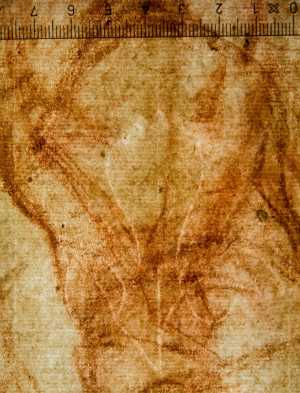Specifications
| Title | Studies of a Seated Male Nude |
|---|---|
| Material and technique | Red chalk, heightened with white |
| Object type |
Drawing
> Two-dimensional object
> Art object
|
| Location | This object is in storage |
| Dimensions |
Height 372 mm Width 253 mm |
|---|---|
| Artists |
Draughtsman:
Pontormo (Jacopo Carucci)
|
| Accession number | I 285 recto (PK) |
| Credits | Loan Stichting Museum Boijmans Van Beuningen (former Koenigs collection), 1940 |
| Department | Drawings & Prints |
| Acquisition date | 1940 |
| Creation date | in circa 1517-1518 |
| Watermark | fruit with two leaves (71 x 48 mm, upside down, centre of folio, on P4 of 7P, vH), similar to Briquet 7386-88 (7392 (Lucca 1516-1518), very similar to but smaller than watermarks of this type in various drawings by Fra Bartolommeo in the Gabburri albums, incl. inv. I 563 M 138 (dated 1515-1516). |
| Inscriptions | ‘No. 230:’ (lower centre, in pen and brown ink); ‘Michelagnolo’ (lower right, in pen and brown ink, partly erased); ‘Raff[aello]’ (verso, right border, in pen and brown ink, partly erased) |
| Collector | Collector / Franz Koenigs |
| Provenance | Jean-François Gigoux (1806-1894, L.1164), Paris; his sale, Paris (Delestre) 20-23.03.1882, lot 163 (Andrea del Sarto); Alphonse Legros (1837-1911, L.140a deest), London; - ; Franz W. Koenigs (1881-1941, L.1023a), Haarlem, acquired in 1929 (Andrea del Sarto); D.G. van Beuningen (1877-1955), Rotterdam, acquired with the Koenigs Collection in 1940 and donated to Stichting Museum Boijmans Van Beuningen |
| Exhibitions | Amsterdam 1934, no. 620; Rotterdam 1938-1939, no. 54; Rotterdam 1997-98; Rotterdam 2010-2011 (coll 2 kw 7, 9); Rotterdam 2016 (Rondom Fra B.) |
| Internal exhibitions |
De Collectie Twee - wissel IX, Prenten & Tekeningen (2011) De Collectie Twee - wissel VII, Prenten & Tekeningen (2010) Rondom Fra Bartolommeo (2016) |
| Research |
Show research Italian Drawings 1400-1600 |
| Literature | Byam Shaw 1929-30, pp. 23-25, pl. 27 (recto) and fig. 6 (verso) (Andrea del Sarto or young Pontormo?); Amsterdam 1934, no. 620 (Pontormo); Venturi 1934, p. 49; Fraenckel 1935, p. 195 (Pontormo); Juynboll 1938, pp. 19-20, ill. 19; Berenson 1938, vol. 2, p. 247, no. 1761D (Naldini); Rotterdam 1938-39, no. 54 (recto and verso: Pontormo); Freedberg/Cox Rearick 1961, p. 8, fig. 19 (verso) and 21 (recto); Freedberg 1961, p. 259, no. 285; Freedberg 1963, p. 71, under no. 34, note 4 (Pontormo); Berti 1964, p. XLII (recto and verso: Pontormo); Cox Rearick 1964, vol. 1, pp. 128-129, no. 37, under no. 38, vol. 2, fig. 44 (recto) and pp. 141-142, no. 64, vol. 2, fig. 68 (verso) (Pontormo); Forlani Tempesti 1967, p. 83, note 6 (recto and verso: Naldini); Berti 1973, p. 93, under nos. 44 to 52 (verso: Pontormo); Florence 1980, p. 174, under no. 404 (verso: Pontormo); Forlani Tempesti 1981, p. 119, 122 note 4 (verso: Pontormo) and p. 122, notes 3 and 6 (recto: Pontormo); Goldner 1988, p. 91, under no. 35 (verso: Pontormo); Fort Worth/New York/Chicago 1994, p. 44, under no. 14 (recto: Pontormo); Costamagna 1994, p. 137, under no. 24 (recto: Pontormo); p. 139, under no. 26 and p. 276, under no. A17 (verso: Pontormo); p. 275, under no. A17 (verso: Pontormo); Falciani 1996, p. 25, under no. II.8 (verso), p. 44, under no. III.2 (recto) (Pontormo); Empoli 2013-14, p. 96, under no. 2 (verso) |
| Material | |
| Object | |
| Geographical origin | Italy > Southern Europe > Europe |
Do you have corrections or additional information about this work? Please, send us a message

























